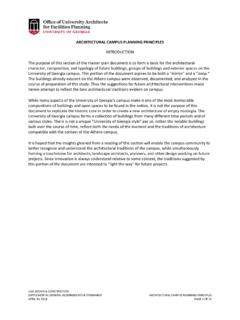Transcription of Occurrence, Texture, and Classification of Igneous Rocks
1 UNESCO EOLSSSAMPLE CHAPTERSGEOLOGY Vol. II - occurrence , texture , and Classification of Igneous Rocks - Gezahegn Yirgu Encyclopedia of Life Support Systems (EOLSS) occurrence , texture , AND Classification OF Igneous Rocks Gezahegn Yirgu Addis Ababa University, Ethiopia Keywords: crystal twinning, crystal zoning, extrusion, felsic, glass, intergrowth, intrusion, IUGS, lava, mafic, magma, mineral, modal composition (mode), normative composition (norm), nucleation, plutonic, polarizing microscope, pyroclast, texture , thin section, viscosity, volcanism Contents 1. Introduction 2. Mode of occurrence of Igneous Rocks Lava Flows and Domes Pyroclastic Deposits Intrusive Bodies Plutons Minor Intrusions Layered Intrusions 3. texture of Igneous Rocks Crystal Nucleation and Growth Common Igneous Textures Crystallinity Granularity Crystal Shapes Mutual Relations of Crystals (and Amorphous Materials) 4.
2 Classification and Nomenclature of Igneous Rocks Classification Scheme for Igneous Rocks Principal Factors in Classification Modal Mineralogy Grain Size Nomenclature Chemical Classification Classification and Nomenclature of Plutonic Rocks Ultramafic Rocks Charnockitic Rocks Classification and Nomenclature of Volcanic Rocks Classification and Nomenclature of Pyroclastic Rocks Other Igneous Rock Groups Acknowledgements Glossary Bibliography Biographical Sketch UNESCO EOLSSSAMPLE CHAPTERSGEOLOGY Vol. II - occurrence , texture , and Classification of Igneous Rocks - Gezahegn Yirgu Encyclopedia of Life Support Systems (EOLSS) Summary In this article, the manner in which Igneous Rocks occur in nature is introduced, followed by a discussion of the general textural features and appearance of these Rocks . The Classification and nomenclature of Igneous Rocks are treated in the final section. Igneous Rocks are formed when magma cools, either on Earth s surface or beneath it, though some may form by fragmentation of solidifying magma.
3 Typical occurrences of Igneous rock bodies on the surface include lava flows, lava domes, necks and spines, and pyroclastic deposits. Plutonic bodies with different dimensions and geometry form by cooling of magma beneath the earth surface, and are exposed at the surface by post-emplacement geological processes and erosion. The term texture is used in the conventional geological meaning for features such as grain shape and size, and spatial relationships between mineral grains in a rock. The subject is discussed in terms of recent research on the nature of crystallization. The recommendations of the International Union of Geological Sciences (IUGS) subcommission for Igneous rock terminology and Classification are illustrated. For the sake of completeness, and in order to provide a general picture of the whole spectrum of Igneous Rocks , also included are a number of types that are either rare or difficult to identify without the use of advanced techniques.
4 1. Introduction For centuries people living near volcanoes have noticed that the red-hot molten material that erupted onto Earth s surface as lava cooled and solidified to give solid Rocks . Lava (from the Italian lavare: to wash) was originally applied to streams of water, and in the eighteenth century in Neapolitan dialect to streams of molten rock from the Vesuvius volcano. The term is now used for the molten material that erupts from volcanoes as well as for the rock that forms on solidification of this material. Rocks resulting from volcanic eruption represent only a small proportion of those Rocks formed by the cooling and crystallization of magma, most of which occurs at depths beneath the Earth s surface. All Rocks represent the final products of a multitude of physical and chemical processes (see Igneous and Metamorphic Petrology; Processes of Magma Evolution, Magmatic Suites and Consequences for the Composition of Continental Crust).
5 Throughout their cooling history all magmatic Rocks try to achieve mechanical and chemical equilibrium, but rarely succeed. As a result, they leave behind trails consisting of wide chemical and mineralogical variations, disequilibrium mineral assemblages, disequilibrium textures, fluid inclusions, and so on, which when taken together, permit us to reconstruct the history of the magmatic rock. This article attempts to cover the description, mode of occurrence , and Classification of Igneous Rocks . The article follows a purely descriptive approach, providing factual data and attaching names to Igneous Rocks . This is not an end in itself, but rather one step toward understanding how rock bodies form and how magmatic eruptions behave. UNESCO EOLSSSAMPLE CHAPTERSGEOLOGY Vol. II - occurrence , texture , and Classification of Igneous Rocks - Gezahegn Yirgu Encyclopedia of Life Support Systems (EOLSS) 2.
6 Mode of occurrence of Igneous Rocks Magmas erupted from volcanoes are either poured out as coherent fluidal lava flows or blown out as fragments of various sizes. A body of magma may also be emplaced and cool beneath the surface of the Earth. Igneous Rocks result from the final solidification of magma at the surface or at variable depths within the Earth, as well as from the eventual consolidation of fragmented debris. Igneous Rocks thus occur in two ways, either as extrusive (on the surface) Rocks or as intrusive (below the surface) bodies. Intrusive Rocks are also called plutonic (Pluto, the Greek god of infernal regions, therefore deep-seated) and extrusive Rocks volcanic. The terms intrusive and extrusive only refer to the place where the rock solidified. Extrusive Rocks cool rapidly because they have erupted at the Earth s surface, but intrusive Rocks cool more slowly within an insulating blanket of surrounding Rocks into which they have been emplaced.
7 The rapid cooling of magma gives a fine-grained rock, which may even be glassy, whereas slower cooling gives coarse-grained rock with large crystals. Lava Flows and Domes In its upward movement, magma may be erupted at the surface from fissures or volcanic vents. Fundamentally, differences in magma composition and volatile content are responsible for all variations between the extremes of quiet lava effusion and catastrophic explosion. Some volcanic eruptions are short and sharp, whereas others drag on for months through various phases with different eruptive styles. Effusive activity is dominated by passive emission of lavas. Lavas may be emitted from fissures or central vents. Several central eruptions may line up along a great fracture or fissure zone. Lava flows extruded on the earth s surface range from a few centimeters to a few hundred meters in thickness.
8 The area may be a few square meters or many square kilometers. Extrusions display a wide range of forms, depending upon their mobility or apparent viscosity. Lava flows are tabular Igneous bodies, generally thin compared with their horizontal extent. The attitude corresponds in a general way to that of the surface upon which they are erupted. On flat plains, the lava flows are more or less horizontal; but on the slopes of volcanoes, they may consolidate with a considerable inclination. Relatively low-viscosity or fluid flows (basaltic magmas) spread out from the vent as thin extensive sheets, whereas viscous rhyolite lavas are thick and short. At the largest scale, there is a clear separation between effusive and explosive styles by composition. Large-volume basaltic eruptions are almost exclusively effusive; large-volume silicic eruptions are exclusively explosive. In general terms, if a volcano is built up by a single eruption, it is called monogenetic.
9 If there are repeated episodes of activity from the vent, a bigger polygenetic volcano results. UNESCO EOLSSSAMPLE CHAPTERSGEOLOGY Vol. II - occurrence , texture , and Classification of Igneous Rocks - Gezahegn Yirgu Encyclopedia of Life Support Systems (EOLSS) Fissure eruptions result when magma-filled dykes intersect the surface. When a dyke of mafic lava breaks through to the surface, huge-volume basaltic flows may be formed. In historic times, the largest example of this phenomenon took place between June 1783 and February 1784, when 14 cubic kilometers of lava flooded from the 25 km length of the Laki Fissure in southern Iceland. Central eruption forms various types of volcanic edifices, among which shield volcanoes and stratovolcanoes are the largest. Shield volcanoes are broad cones with low angles of slope, built chiefly of fluid basaltic lava emitted prevailingly from a central area. Stratovolcanoes are formed by mixed effusive and explosive activity, and consist of alternating lava flows and pyroclastic deposits.
10 In central volcanoes, variable amounts of lava and tephra erupt from vents or fissures on the side of the cone. Very symmetrical volcanic cones (for example, Mayon in the Philippines, or Fuji in Japan) are built up by lavas and pyroclastic deposits emitted almost exclusively from a central vent. Other asymmetrical large volcanoes are more complex, and result from eruptions that took place both from the summit vent, and from various craters along the flanks. In volcanic complexes resulting from fissure eruptions accompanied by swarms of feeders, areas of several hundred square kilometers may be flooded by lava flows amounting to thousands of meters in total thickness. These are known as large Igneous provinces (LIPs). Most LIPs, such as the Deccan Plateau of western India, the Parana of South America, and the high plateaus of Ethiopia and East Africa, have been constructed primarily by fissure eruptions.














